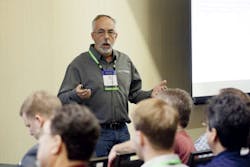Heed the Hybrid Cloud
Cloud computing is a technology trend that is not going away, as companies increasingly turn to software-as-a-service applications in an effort to circumvent capital expenditures. But the cloud is not the answer to all infrastructure issues. In fact, businesses must be strategic about what applications they move offsite, as well as how they do it.
For the past several years, Schneider Electric has been working with customers to understand the best approach when it comes to moving industrial software to the cloud. After much research, the company offered further details in San Antonio, Texas, at its Innovation Summit: Software Conference 2017. At this event, details on its cloud vision were revealed, which includes a hybrid strategy.
“Our hybrid approach makes it somewhat unique, because we don’t say get rid of all your on-premise software and move to the cloud,” said Jim Chappell, Vice President of Information Solutions at Schneider Electric. “We say leverage your existing investment in software, both from Schneider and third parties, and we’ll give you a roadmap to the cloud. We can leverage both on premise and cloud systems in a way that they work together securely and follow standard IT practices.”
Schneider Electric is creating a unified and immersive experience that converge applications in a way that work together seamlessly—regardless of where they reside—while delivering clear business value. “We don’t want to turn the cloud into an application junkyard,” Chappell said.
While InSight powered by Wonderware Online is the existing cloud platform—and remains—a year ago, it was focused on taking data from sensors and doing trending. Since then, however, it’s transformed and continues to expand as new applications emerge. To that end, the hybrid cloud will deliver a common user experience so that data flows regardless of what product is being used. Common core services around authentication, search and visualization will provide the foundation for scalability. And, an information layer will publish apps based on the business logic.
That means, while the functionality of Schneider Electric’s industrial software won’t change, the way it is being delivered will. “As we bring these applications to the cloud, we have to rethink them,” Chappell said. “We won’t take a 20-year old app and bring it to the cloud. We have to rethink it, as it has to be frictionless.”
Schneider’s manufacturing execution system (MES) and asset performance management software (APM) are the first hybrid cloud applications available. The new suite of MES apps are designed for the cloud, but some aspects of it will be pushed back down to run locally on an on-premise edge device. For example, a user may have material management running in the cloud, but mission critical applications that require availability would run on-site. Similarly, the new version of APM can run on- or off-premise. It also includes speed improvements, enhanced mobility and improved intelligence in the cloud that will enable prognostics, or future predictions.
What’s important in this hybrid set up is that the user does not need to know where the application is running. And, while the app may run on site, it may still be managed from the cloud. “The edge devices will be more like a black box to you,” said Tom Troy, Director of Schneider Electric’s Operations and Execution portfolio. “You won’t know what is running there. We want to take that away from you. We’ll push the apps to you to make it easy to maintain.”
Despite the app that is running, the user experience will be common, yet very tailored. For example, when a user logs in, he or she will see the application through a “lens” that is specific to him or her. A maintenance person will see the sites he or she is responsible for. A manager will see higher level data over a wider area.
And, the data will be delivered in an intuitive way to help the user drill down into the issues. Rather than searching for information, the information is delivered in plain English, like this: “A filler on line #17 is running lower (PSI) than usual: When this happens we typically incur downtime 87% of the time.”
Schneider Electric continues to invest and evolve its hybrid cloud offerings, and the end users will ultimately benefit by being able to easily operate sophisticated industrial software. It can also help large multi-site customers build a support Center of Excellence (CoE) to push out standards across multiple plants. Analytics are becoming cutting-edge in the cloud. And, operators will work very differently.
“The operators of the future will have a digital assistant guiding them along,” Troy said. “And the assistant will give them good direction. These are the kind of neat things coming as we build this platform.”

